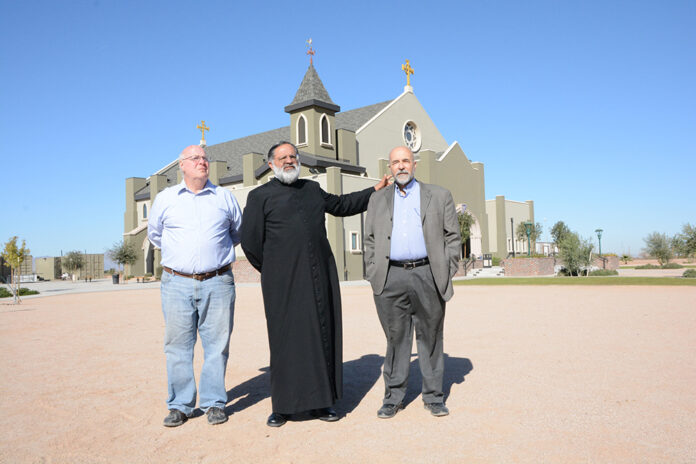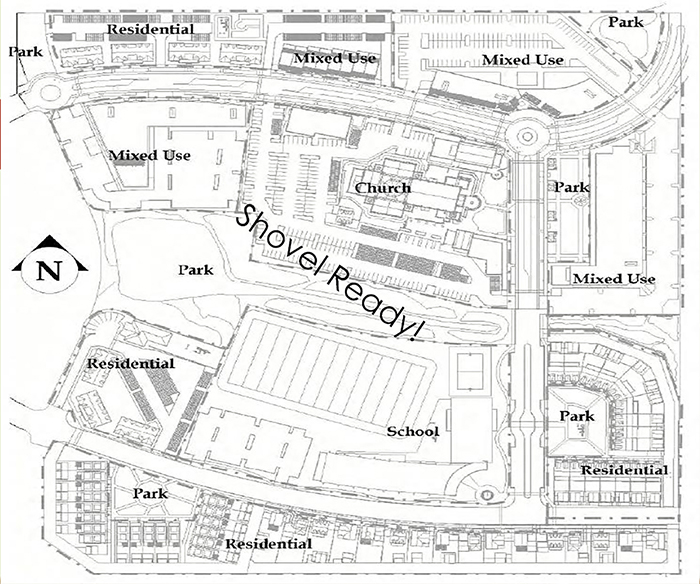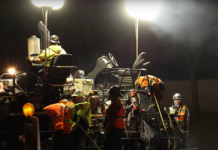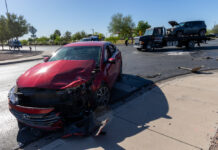
The Catholic church intends to create its own village center that will be a mix of businesses, housing and a school. The property known as The Crossing is 20 acres surrounding Our Lady of Grace’s two-story church.
The building was decades in the making, but it was only the first step in the development vision. Now Our Lady of Grace is ready to get down to business.
“We’re going to focus on unique,” said Ken Lepper, chairman of the Our Lady of Grace Catholic Church Construction and Design Oversight Committee.
Lepper came from The Woodlands, a planned community in Texas, where he sat on village boards and the overall community board. He would like to see a similar village concept of a maintainable, walkable community at The Crossing.
“It will be a two- to three-year development effort to get things moving,” Lepper said. “There’s a chance that [in 2018] we’ll have some stuff starting or at least contracted.”
Kim Renfro, chairman of the finance committee, touted the idea of senior living and assisted living facilities as well as residences for Alzheimer’s patients. A parishioner at Our Lady of Grace for a dozen years, he said the committee is also looking for a “high, high-end charter school” and apartments.
“The city really needs apartments,” Renfro said.
The Crossing is pre-zoned for high-density housing. The committee has looked at HUD-funded grants, which require scoring well on government scorecards. The committee found one thing it does not score well on is distance to a hospital.
The plans also include retail, professional offices, medical offices and a grocery. Lepper said the school is an important element.
“What kind of school we don’t know yet – Catholic school, charter school, private school, military school,” he said.
“The concept is to get a mix of businesses that people will want to come to and housing that people will want to live in, with services that are nearby.”
 The church’s plans were city-approved in 2012. In the years since, changes in Maricopa’s marketplace have caused the church’s development committee to alter its plans.
The church’s plans were city-approved in 2012. In the years since, changes in Maricopa’s marketplace have caused the church’s development committee to alter its plans.
“When this was first envisioned, there weren’t near as many retail outlets as there are now,” Lepper said. “The city has really changed in terms of what’s available and how it’s growing, so we need something that’s a draw.”
They have even been approached by the developer of a microbrewery.
As a tax-exempt entity entering the world of business, Our Lady of Grace is still forming the legal framework.
“We will probably have a separate entity that the church will control through CC&R’s and some others, assuming real estate law tells us it’s what we have to do,” Lepper said. “The bottom line is, we’ll do whatever we legally have to do to develop the property and maximize the benefit to the church.”
The Crossing is shovel-ready. To keep it looking prime and ready for development, Our Lady of Grace has leaned on the volunteer labor of generous members who were vital to the building of the church.
Rev. Marcos Velásquez said that kind of dedication has been very important to the development of The Crossing. The church itself is emblematic of the devotion of the members, with many elements created or donated by parishioners. That has happened with the grounds as well.
“Before we even started building over here,” Lepper said. “Mike Mills [of Ellison-Mills Contracting] came out after church at our old place and he said, ‘Here’s my card. I run a construction company, and we work primarily with movement of dirt, plumbing, electrical, trenching, all that stuff.’ And he said, ‘If I can ever help, let me know.”
Two years later, Lepper took him up on the offer. Mills moved dirt to fill in an unnecessary retention basin, cleared land for the annual fair, worked weed control, watered down dirt (with water he paid for) to control dust and paid to clean the private streets. It all helped Our Lady of Grace meet its maintenance requirements.
“I’ve always been taught if you receive grace, you should be giving back,” Mills said.
Besides reaching within the congregation, the church is busy networking and forging new relationships in the community and marketplace to begin developing The Crossing.
“It’s staged,” Lepper said. “It’s ready for the right investment and interest level. There’s no doubt that this can be successful.”
This story appears in the January issue of InMaricopa.




![Shred-A-Thon to take place tomorrow An image of shredded paper. [Pixabay]](https://www.inmaricopa.com/wp-content/uploads/2024/03/shredded-paper-168650_1280-218x150.jpg)












![Shred-A-Thon to take place tomorrow An image of shredded paper. [Pixabay]](https://www.inmaricopa.com/wp-content/uploads/2024/03/shredded-paper-168650_1280-100x70.jpg)
“The city really needs apartments,” Renfro said.
Why? Isn’t high density housing typically located near areas of large scale employment or universities? If you put in Apartments we’ll just have more people (with less disposable income) commuting on the 347.
IMHO
Dear Retired Sailor Guy…apartments provide an affordable alternative to home ownership for a variety of folks who can’t afford or don’t want a home. Hundreds of folks drive in to Maricopa from surrounding communities to work in local businesses. If Maricopa wants to grow and attract a wide spectrum of salaried and hourly workers and make the city attractive to new developers and businesses, we need more workers who can afford to live in the city. Homes that were purchased during the crash are being sold for single families instead of rented out in increasing numbers: we have a shortage of available rentals in today’s market and a tight inventory of available new homes. Go to http://www.maricopamatters.com to see the paid study undertaken by the city for future development and needs.